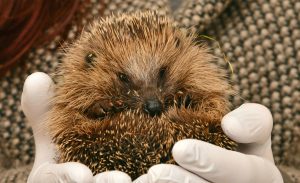By Matt Niederhuber
North Carolina has had a miserable winter this year, with a heavy dose of snow and bitter cold – so much that you might wish you could climb under a warm blanket and hibernate till May. Unfortunately, humans can’t hibernate like many of our mammalian relatives, and we’re forced to suffer through till Spring.
But why can’t humans hibernate? The answer has everything to do with energy.
Hibernation is a common technique that many mammals and even some birds use to help them survive when food sources are scarce, which is often in the winter when it’s cold and snowy out. When animals hibernate, they drastically lower their body temperature from around the normal 37C (98F) to a almost freezing 5C (41F). Their heart rates drops and so does their metabolism (the process that convert food to energy). So, hibernation is dramatically different than just going to sleep for a long time–it’s a serious physiological change.

Wild hedgehogs can hibernate depending on their surrounding conditions. Source
The main point of all these changes is to conserve energy. Mammals are “endotherms”, which means they generate their own heat to sustain a relatively high and steady body temperature relative to their surroundings. That lets mammals like us maintain a high rate of metabolism and do energetically expensive things, like using our brains or finding food, even when it gets cold out.
But, the cost of staying active in cold weather is that it also takes a lot of energy to keep the body warm. It’s especially tough for small mammals which lose heat more easily than larger animals. That’s why most hibernators like the Mountain pygmy possum and the Hazel dormouse tend to be small.
So during the winter, or any period when food is hard to find, some animals hibernate to conserve energy. While hibernating mammals are able to reduce their overall energy consumption to less than 15% of what they normally use. If they stayed active instead of hibernating, these animals might use more energy heating themselves in the cold than they could possibly find to eat!
There are some misconceptions about hibernation, though.
For one, when an animal hibernates it doesn’t stay in a deep “topor,” the term to describe the physical changes of lowered body temperature and reduced metabolism, for the entire time. In truth, even when hibernation spans several months, the state of topor is broken up by regular periods of rewarming and metabolic arousal. Why hibernators do this isn’t well understood, but it may have something to do with keeping the body and brain healthy during long periods of hibernation.
Another major misconception is that bears are a great example of hibernators. While bears do a type of hibernation, it is a much less severe change than the deeper states of topor that smaller mammals enter. When bears hibernate, they only reduce their body temperature from 37C (98F) to about 30C (86F), which is a lot warmer than most other hibernators. The other important difference is that they are much more easily woken up from hibernation than other animals. So generally it’s good advice not to bother hibernating bears.

Black Bears go into a less dramatic type of hibernation during the winter months. Source
Okay, but why don’t us humans hibernate? Well it probably has a lot to do with where we evolved. Since the earliest humans arose in equatorial Africa, where it’s relatively warm, there might not have been the same kind of changes in food supply that would make seasonal hibernation beneficial.
There’s also the minor problem that we simply don’t have the right biology to survive the kind of dramatic drop in body temperature that hibernators experience. The heart cells of small hibernating animals are able to fine tune how much calcium they have, too much or too little and the heart can’t pump blood. This let’s them survive when their bodies are at near freezing temperatures. Human heart cells can’t do this, and simply can’t work when we get too cold.
Even though humans don’t hibernate, that isn’t stopping some scientists from trying to figure out a way to induce a shallow kind of human hibernation or suspended animation. If we could put humans into a kind of hibernation, maybe with a smaller drop in body temperature, there could be some major benefits. For instance, a hibernating astronaut might be able to spend longer periods of time in space, or putting a patient into a state of hibernation might make surgery easier and less risky.
These are exciting ideas, but right now they are just hypothetical possibilities since we still don’t fully understand the physical mechanisms that make hibernation possible. That means there’s a lot to still figure out, and that for the time being we have to go to work and school even though it’s grey and only 20 degrees outside.
Edited by Yitong Li and Allyson Roberts
